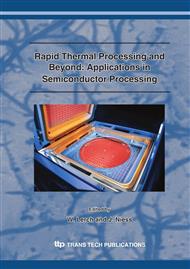p.3
p.21
p.35
p.45
p.61
p.77
p.119
p.133
Rapid Thermal Processing and the Control of Oxygen Precipitation Behaviour in Silicon Wafers
Abstract:
The use of Rapid Thermal Processing to install lattice vacancy profiles into silicon wafers for the purpose of forming a template for the nucleation and ideal control of oxygen precipitation has become an important materials engineering tool for the microelectronics industry. This paper reviews the principles of the technique and the precise materials/defect engineering that it engenders. It furthermore discusses what has been learned regarding the elusive properties of the intrinsic point defects in silicon through studies of the distributions of vacancies created by use of the technique. Also discussed are recent discoveries about the critical role of the other intrinsic point defect, the self-interstitial and the development of oxygen precipitates and their distributions post-nucleation and the critical importance of what has become to be called the “ninja transformation” in the switching-on of gettering efficiency of oxygen precipitate systems.
Info:
Periodical:
Pages:
45-60
Citation:
Online since:
March 2008
Authors:
Price:
Сopyright:
© 2008 Trans Tech Publications Ltd. All Rights Reserved
Share:
Citation:


